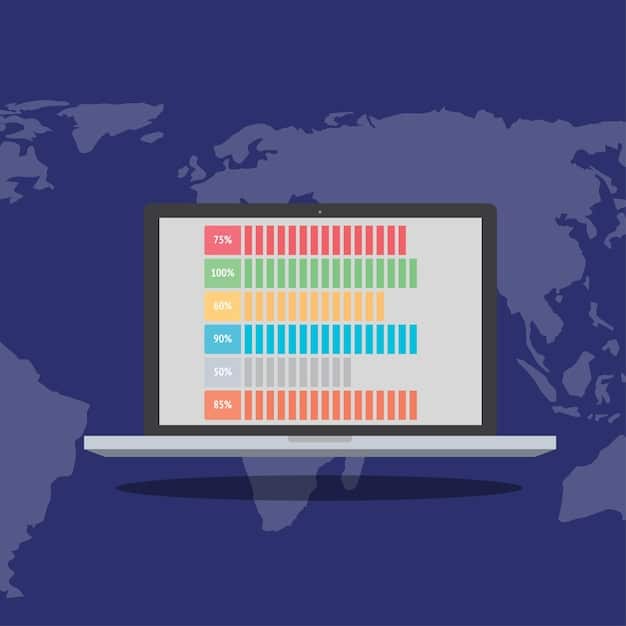Streaming Service Data Usage: Tips to Reduce Bandwidth Consumption

Streaming service data usage can be a significant concern for many households, but understanding how to manage and reduce bandwidth consumption can help optimize your streaming experience and potentially lower internet costs.
Are you tired of buffering screens and exceeding your monthly data allowance? Streaming service data usage can quickly eat into your bandwidth, but there are effective strategies to reduce your consumption and enjoy uninterrupted entertainment.
Understanding Streaming Service Data Usage
Streaming services have revolutionized the way we consume content, offering on-demand access to an extensive library of movies, TV shows, and music. However, this convenience comes with a cost: increased data consumption. Understanding how different factors influence your streaming service data usage is the first step toward managing it effectively.
Factors Influencing Data Usage
Several elements determine the amount of data you use while streaming. These include video quality, streaming duration, and the number of devices streaming simultaneously.
- Video Quality: Higher resolutions like 4K consume significantly more data than standard definition (SD).
- Streaming Duration: The longer you stream, the more data you use. Binge-watching can lead to substantial data consumption.
- Number of Devices: Streaming on multiple devices at the same time multiplies your data usage.
Being aware of these factors allows you to make informed decisions and adjust your streaming habits to reduce bandwidth consumption.
Ultimately, understanding the various factors influencing data usage is crucial for effectively managing and mitigating bandwidth consumption while enjoying your favorite streaming content.

Optimizing Video Quality Settings
One of the most impactful ways to reduce your streaming service data usage is by optimizing your video quality settings. Most streaming platforms offer a range of options, allowing you to adjust the resolution and, consequently, the amount of data consumed.
Adjusting Resolution
Lowering the resolution from 4K to HD or SD can significantly reduce data usage without drastically affecting the viewing experience, especially on smaller screens.
Automatic vs. Manual Settings
While automatic settings adjust video quality based on your internet speed, manual settings give you more control over data consumption.
- Automatic Settings: These settings can sometimes default to higher resolutions than necessary, leading to unnecessary data usage.
- Manual Settings: Choosing a lower resolution manually ensures you stay within your data limits.
- Data Usage Estimates: Some platforms provide data usage estimates for each resolution setting, helping you make informed decisions.
Adjusting video quality settings is a simple yet effective method for reducing your overall data consumption, enabling you to enjoy streaming without exceeding your monthly data limits.
In summary, taking control of video quality settings is a straightforward strategy to minimize data usage while maintaining an enjoyable streaming experience. By opting for lower resolutions and understanding the implications of automatic settings, you can effectively manage your bandwidth consumption.
Monitoring Your Data Usage
Tracking your streaming service data usage is essential for staying within your internet plan’s limits. Monitoring your usage helps you identify high-consumption periods and adjust your streaming habits accordingly.
Using Router Settings
Most modern routers offer built-in tools to monitor data usage, providing insights into which devices and applications are consuming the most bandwidth.
Utilizing Streaming Platform Tools
Some streaming services provide their own data usage trackers, allowing you to monitor consumption directly within the platform.
- Real-time Data: These tools often display real-time data usage, helping you identify immediate consumption patterns.
- Historical Data: Access to historical data allows you to analyze trends and make informed decisions about your streaming habits.
- Alerts and Notifications: Some platforms offer alerts when you approach your data limit, helping you avoid overage charges.
Regularly monitoring your data usage allows you to fine-tune your streaming habits, ensuring you remain within your data allowance and avoid unexpected costs.
In conclusion, monitoring your data usage through router settings and streaming platform tools is a proactive way to manage bandwidth consumption. By tracking your usage, you can identify areas where you can reduce data consumption and stay within your data limits.

Downloading Content for Offline Viewing
Did you know that downloading content for offline viewing can significantly reduce your streaming service data usage? Instead of streaming the same content multiple times, downloading allows you to watch it without using any additional bandwidth.
Benefits of Downloading
Downloading content not only saves data but also provides a buffer against internet connectivity issues.
Available Platforms
Many streaming platforms, such as Netflix, Amazon Prime Video, and Disney+, offer the option to download movies and TV shows for offline viewing.
- Travel: Downloading content is particularly useful when traveling, as it allows you to enjoy your favorite shows without relying on potentially expensive or unreliable internet connections.
- Commuting: Download content before your commute, and watch it on the go without consuming mobile data.
- Data Caps: Downloading helps you stay within your data limits by reducing the need for continuous streaming.
Downloading content for offline viewing is a practical strategy for reducing your overall data consumption while enjoying uninterrupted entertainment.
In summary, downloading content for offline viewing offers a dual advantage: it reduces data usage and provides a seamless viewing experience irrespective of internet connectivity. By leveraging this feature, you can significantly lower your bandwidth consumption and enjoy your favorite content on the go.
Adjusting Audio Quality
Adjusting audio quality is another simple yet effective method to reduce your streaming service data usage. While video quality often takes center stage, audio settings can also impact your bandwidth consumption.
Lowering Bitrate
Lowering the audio bitrate can decrease data usage without significantly affecting the listening experience, especially on devices with smaller speakers or headphones.
Platforms with Audio Settings
Some streaming services allow you to adjust audio quality settings independently of video quality, providing greater control over data consumption.
- Music Streaming: For music streaming services like Spotify or Apple Music, opting for lower audio quality settings can save significant data.
- Podcasts: Similar to music, reducing the audio quality for podcasts can also contribute to lower data usage.
Adjusting audio quality settings is a subtle yet effective way to fine-tune your streaming experience and reduce your overall data consumption.
Ultimately, adjusting audio quality settings is a straightforward tactic for minimizing data usage, particularly when streaming music or podcasts. By selecting lower bitrates, you can conserve bandwidth without sacrificing too much on the listening experience.
Managing Background Data Usage
Background data usage from other apps and devices can contribute to your overall bandwidth consumption, making it essential to manage this aspect to reduce your streaming service data usage successfully. Preventing unnecessary background data usage ensures that your bandwidth is primarily used for streaming.
Closing Unused Apps
Closing apps that are running in the background can prevent them from consuming data unnecessarily.
Disabling Auto-Play Features
Many social media apps and websites have auto-play features that can consume data even when you’re not actively using them. Disabling these features can save a considerable amount of bandwidth.
- Mobile Data: On mobile devices, restricting background data usage for specific apps can prevent them from consuming data when you’re not connected to Wi-Fi.
- Software Updates: Schedule software updates to occur when you’re connected to Wi-Fi to avoid using your mobile data.
Effectively managing background data usage ensures that your bandwidth is optimized for streaming, reducing overall consumption and preventing unexpected data overages.
In conclusion, managing background data usage is crucial for optimizing your bandwidth consumption. By closing unused apps, disabling auto-play features, and restricting background data on mobile devices, you can ensure a more efficient and streamlined streaming experience.
Upgrading Your Internet Plan
If you consistently exceed your monthly data allowance despite implementing various data-saving strategies, upgrading your internet plan may be necessary to support your streaming service data usage. Assess your current usage patterns and choose a plan that aligns with your needs to avoid overage charges and enjoy uninterrupted streaming.
Assessing Your Needs
Evaluate your current data usage and identify peak consumption periods to determine the appropriate internet plan for your household.
Choosing the Right Plan
When selecting an internet plan, consider both the data allowance and the internet speed, as both factors can impact your streaming experience.
- Unlimited Data Plans: If you stream frequently and have multiple devices connected to the internet, an unlimited data plan might be the best option.
- Higher Data Caps: Opt for a plan with a higher data cap if you find that your current allowance is insufficient.
Upgrading your internet plan can provide the necessary bandwidth and data allowance to support your streaming habits, ensuring a seamless and enjoyable entertainment experience.
In essence, consider upgrading your internet plan if you consistently struggle with data limits. An upgraded plan can provide the required bandwidth and higher data caps necessary to meet your streaming needs, ensuring uninterrupted entertainment and peace of mind.
| Key Point | Brief Description |
|---|---|
| 📺 Optimize Video Quality | Reduce resolution to lower data consumption. |
| 💾 Download for Offline | Download content to avoid repeated streaming. |
| 🔊 Adjust Audio Settings | Lower audio bitrate for music and podcasts. |
| 📱 Manage Background Data | Close unused apps and disable auto-play features. |
[Título da seção FAQ em en-US]
Frequently Asked Questions
Higher video qualities, such as 4K, require more data per minute of streaming compared to standard definition (SD) or high definition (HD) content.
Yes, downloading movies and shows when connected to Wi-Fi allows you to watch them later without using any additional mobile data.
Many streaming platforms provide data usage statistics within their app settings or on their website under your account details.
Auto-play features can consume data by playing videos automatically, even when you’re not actively watching. Disabling them can save bandwidth.
If you consistently exceed your data limits, upgrading to a plan with more data or unlimited data may be a practical solution.
Conclusion
Managing streaming service data usage doesn’t have to be a daunting task. By implementing these strategies—optimizing video and audio quality, monitoring your data, downloading content, managing background data, and upgrading your internet plan if necessary—you can enjoy your favorite streaming services without worrying about exceeding your bandwidth limits.





